Kensington Apartments, 11 Commercial Street
2013 7- and 12-storey blocks of flats and shop, site of 1854-5 Baptist Chapel and former 21 Commercial St (before 1878 11 Commercial St) | Part of New Holland Estate
Baptist Chapel
Contributed by Survey of London on Dec. 20, 2018
Between 1854 and c.1910 an imposing Baptist Chapel stood on the site of the lower section of Kensington Apartments. It had some claim to be the oldest Baptist congregation in London and was built to replace the chapel of 1730 in Little Prescot Street, at the south end of Mansell Street, which had been troubled for some years by ‘the constant thunder of railway engines’ and whose site was needed for the Blackwall Railway development.1 The builder of the Commercial Street Baptist Chapel was John Wood & Son of New North Road, the architect Joel Foster Earle (1823-86), from an extensive family of builders and sculptors in Hull, who had trained as a Baptist minister before becoming an architect.2 Railway compensation of £6,560 paid for the freehold site (£2,900), 85ft wide and 88ft deep. The chapel, to seat around 800, was fronted by a full-width pediment over a distyle in antis Corinthian portico. Steps rose within to a central entrance flanked by doors to staircases to the galleries, which stood on iron columns running round three sides. The moveable dais at the west end covered the baptistery and entrance to vestries, and accommodated the pulpit from the old Prescott Street chapel. A schoolroom and lecture hall c. 40ft by 27ft was located on the south side.3
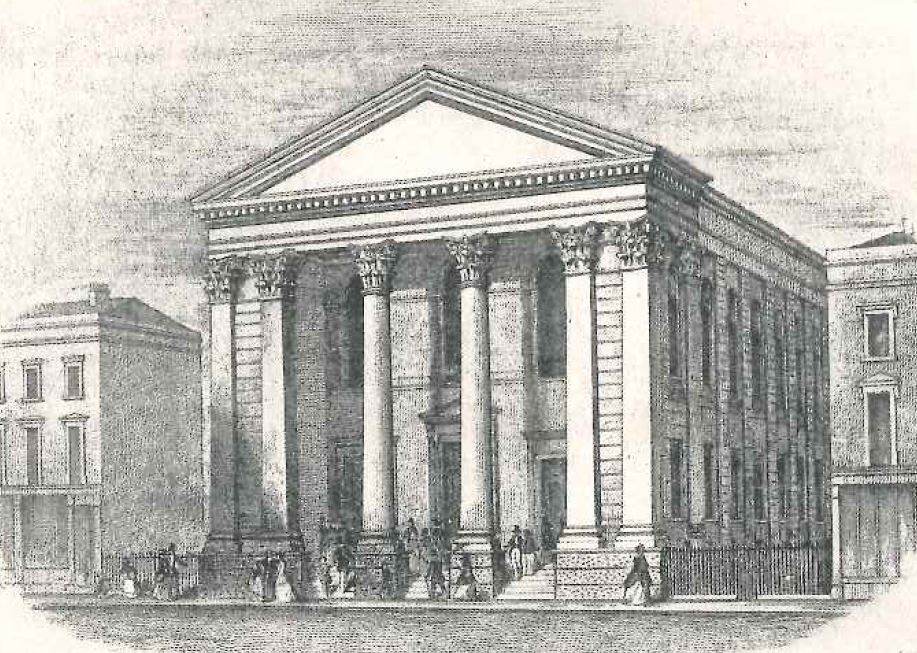
It was an active congregation under its excitable and energetic minister, Charles Stovel (1799-1883), an anti-slavery campaigner. There were lectures against Christian evangelism in India, and slavery in the American South, and by Stovel himself on ‘The Sin of Exacting Excessive Labour’ in support of the Early Closing Association.4
The Baptist chapel’s congregation was evidently dwindling even before Stovel’s death in 1883. A visitor in 1875 found the congregation already ‘small’, in such a large building.5 By 1888 attendance was down to around 120 and in the summer of 1893 the site had caught the eye of Samuel Barnett and his associates hoping to build the Whitechapel Gallery.6 Negotiations continued sporadically until the summer of 1896 when they petered out, Barnett’s friend, the Baptist minister Dr John Clifford, reporting that ‘There is still an indisposition to leave the place, a clinging to the hope that better days may come’.7 The Baptists struggled on in Commercial Street till 1909, when they sold the building to the Metropolitan Police, and after a temporary sojourn in a room in Alie Street, the remnants of the congregation merged with a congregation in Walthamstow, which continued, as Grace Baptist Church, until closure in 2014.8
-
A memorial of mercies, trials and deliverances, realised by the first Baptist Church in Removing from Prescot Street to Commercial Street, London 1856 ↩
-
The Earle family of Kingston-upon-Hull: Census: Ancestry: London Metropolitan Archives (LMA), District Surveyor's Resturns (DSR) ↩
-
Baptist Reporter and Missionary Intelligencer, Aug 1855, p. 249: Builder (B), 27 Sept 1856, p. 530 ↩
-
H. Leon McBeth, The Baptist Heritage: Four centuries of Baptist Witness, Nashville, TN, 1987 p. 302: East London Observer (ELO), 21 Sept 1861, p. 2: ↩
-
ELO, 16 Jan 1875, p. 5 ↩
-
The Religious Census of London, London 1888, p. 22 ↩
-
Whitechapel Gallery Archives, EAR 1/5 ↩
-
Shoreditch Observer, 9 Aug 1908. p. 5: E.R. Kevan, London’s Oldest Baptist Church, London 1933, p. 160: information Abigail Gardner, Grace Baptist Partnership ↩
Aldgate Police Section House, 21A Commercial Street
Contributed by Survey of London on Dec. 20, 2018
Aldgate Police section house was erected on the site of the Commercial Street Baptist Chapel in 1910-11 to the designs of the Metropolitan Police Architect, J. Dixon Butler. 1 It was of unusually spartan design, two shallow parallel six-storey blocks joined at the south end by a curve-ended staircase block. It survived war damage, and a timber clubroom and gym were added on the adjoining bomb site to the south.2 The section house closed in the autumn of 1964 and was demolished c.1966 for the New Holland estate.
-
Building News (BN), 28 Oct 1910, p. xl: The National Archives (TNA), IR58/84840/5721 ↩
-
Goad insurance plans: information Reg Denny, ex Metropolitan Police: ‘Scenes around Toynbee hall’, Associated Press Archive film, 1964 ↩
Kensington Apartments and Bradbury House
Contributed by Survey of London on Dec. 16, 2018
Kensington Apartments on the corner of Commercial Street and Pomell Way was built as part of the regeneration of the New Holland estate centred around Denning Point tower. Of twelve storeys, dropping to seven storeys along Commercial Street, it consists entirely of private flats, with a large and luxurious entrance foyer and reception area. The wall finish to Kensington Apartments is ivory rainscreen cladding, with projecting balconies with coloured glazing on the south, Pomell Way frontage, and continuous balconies on the east and west frontages. The taller portion of Kensington Apartments has a communal roof garden.1
The name ‘Kensington’, as with Sloane Apartments, with its desirable West End associations, was presumably chosen in order to boost sales to overseas buyers unfamiliar with the East End. It was built on the site of Bradbury House, a four-storey block of flats built over ground-floor parking garages, a rectilinear concrete-framed block faced in dark-grey brick, with strips of expressed concrete floorplates, part of the New Holland estate.
-
Tower Hamets planning applications online ↩
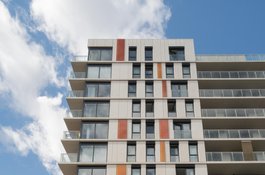
Entrance to Kensington Apartments, August 2017
Contributed by Derek Kendall
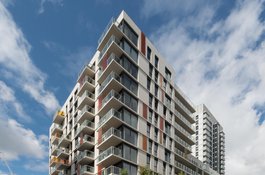
Kensington Apartments with Bradbury Court beyond, August 2017
Contributed by Derek Kendall
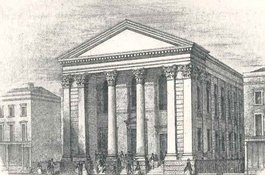
Commercial Street Baptist Chapel, built 1854-5, dem. c. 1910
Contributed by Aileen Reid
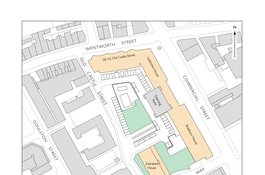
New Holland Estate in 2010 and 2015 - drawing by Helen Jones
Contributed by Survey of London
Estate agent's video showing interior of flat in Kensington Apartments and views north and east, February 2016
Contributed by Aileen Reid on Sept. 12, 2016
Police section house on the site of Kensington Apartments
The first few seconds of this unissued silent newsreel footage offers a rare glimpse of the police section house (a lodging house for single police officers) that was built on the site of the former Methodist chapel c. 1912. It was damaged in the war and demolished for Bradbury House, as art of the Denning Point development, itself demolished c. 2013 for the building of Kensington Apartments
Contributed by Survey of London on Nov. 27, 2017